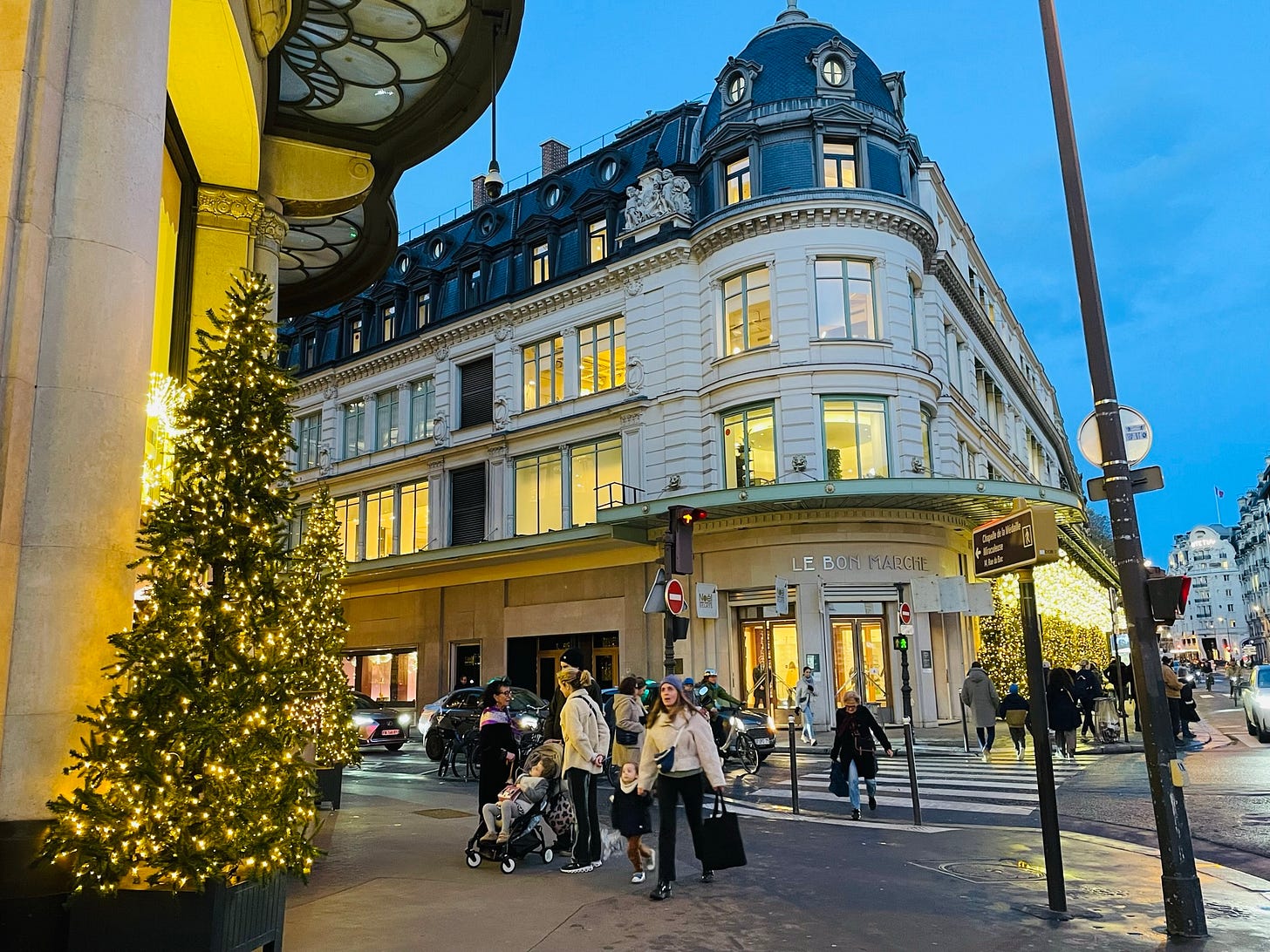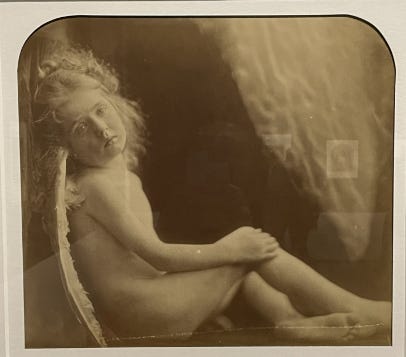Julia Margaret Cameron: Capturing Beauty
Exhibit in Paris captures the ambition and accomplishments of this pioneering artist
This week’s letter is about my visit to the Julia Margaret Cameron exhibition in Paris. After my recent love fest with Virginia Woolf’s To the Lighthouse, I couldn’t miss it. (Woolf was Cameron’s grand-niece.)
Julia Margaret Cameron
The exhibit called “Julia Margaret Cameron: Capturing Beauty” at the Jeu de Paume museum in the Tuileries Gardens runs through January 28, 2024. One of the quotes on display from her autobiographical essay, “Annals of My Glass House,” was: “I longed to arrest all beauty that came before me, and at length the longing has been satisfied.” Here are all the things I loved learning about her and her work, and I think you will too!

I love that she came to photography later in life. She received her first camera as a gift from her daughter and son-in-law when she was 48 years old. They thought it would amuse her. Instead, it appears to have consumed her. She approached photography as an art and her camera as a kind of lover. She writes, “The gift from those I loved so tenderly added more and more impulse to my deeply seated love of the beautiful and from the first moment I handled my lens with a tender ardour, and it has become to be as a living thing, with voice and memory and creative vigor.”
I love the zeal with which she went after mastery in this new form. In 1864, once she had turned her chicken coop into a studio, had learned how to handle the box and plates and chemicals, and had convinced a child to sit still long enough to be captured, she made her first portrait. (Sitters had to sit still for 3-7 minutes!) She lovingly describes her success: “I was in a transport of delight. I ran all over the house to search for gifts for the child. I felt as if she entirely had made the picture. I printed, toned, fixed and framed it, and presented it to her father that same day.” She called it “My First Success.”
I love that, from the beginning, Cameron signed her works and thought of them as works of art. Inspired by the Renaissance masters and ignoring the photographic conventions of her day, she staged and focused her portraits (and nearly all of her photographs were portraits) to suit her own perception of what was beautiful. She explains, “when focusing and coming to something which, to my eye, was very beautiful, I stopped there instead of screwing on the lens to the more definite focus which all other photographers insist upon.”
Cameron thus became, as the exhibition guide explains, “a pioneer of the close-up who frequently adopted soft focus.” The slightly blurry look would become a hallmark of fine art photography (as opposed to commercial or hobby photography) through the early twentieth century. (I googled “pioneer of soft focus photography” and the results were all about Cameron.) In fact, she was one of the earliest practitioners of photography as an art, although she seems to be rarely credited as such, Alfred Stieglitz usually claiming that honor later at the turn of the twentieth century. This probably has much to do with the fact that she was a woman, and her career was cut short when she moved to Ceylon in 1875, where she died in 1879. It seems she was forgotten soon after, except for by Virginia Woolf, who, with Robert Fry, published a collection of her photographs in 1926.
I love that this self-taught artist took her work so seriously that she copyrighted it and began exhibiting it as early as the spring of 1865, sending it off to Scotland and Germany, where she began to receive recognition. That same year, she had a solo exhibition, and the South Kensington Museum, which would become the Victoria and Albert Museum, began to collect as well as exhibit her work. She was elected to the Photographic Society of London and exhibited there as well. She also sold her portraits, taking pictures of eminent men like Tennyson and Darwin, who visited the Isle of Wight, where she was then living. Yet her portraits were wholly unlike the commercial portraiture of the day in that they were large format, often allegorical, and employed strong contrast and soft lighting. “For Cameron, a devout Christian,” the exhibit guide explains, “each one of her portraits was a process of idealization and the ‘embodiment of a prayer’—a kind of epiphany.”
I love that she stayed true to her vision of photography in the face of sometimes harsh criticism. Despite being criticized for what were perceived as blemishes, particularly scratches and spots that were byproducts of the process, she refused to retouch or perfect her images. And she found enough support elsewhere to carry on: “Artists, however, immediately crowned me with laurels, and though ‘Fame’ is pronounced ‘The last infirmity of noble minds,’ I must confess that when those whose judgement I revered have valued and praised my works, ‘my heart has leapt up like a rainbow in the sky,’ and I have renewed all my zeal.”
I also love that Cameron’s husband encouraged and supported her in her work. “My husband from first to last has watched every picture with delight,” she says, “and it is my daily habit to run to him with every glad upon which a fresh glory is newly stamped, and to listen to his enthusiastic applause.”
I’ve included here some of my favorite portraits from the exhibition. I was also delighted to see this portrait of Julia Stephen (née Jackson), her niece, mother of Virginia Woolf.
Most of all, I love Cameron’s tenacity, which Woolf describes beautifully in her biographical essay:
Like a tigress where her [six] children were concerned, she was as magnificently uncompromising about her art. Brown stains appeared on her hands, and the smell of her chemicals mixed with the scent of the sweet briar in the road outside her house. She cared nothing for the miseries of her sitters nor for their rank. The carpenter and the Crown Prince of Prussia alike must sit as still as stones in the attitudes she chose, in the draperies she arranged, for as long as she wished. She cared nothing for her own labours and failures and exhaustion. . . . Painters praised her art; writers marvelled at the character her portraits revealed. She herself blazed up at length into satisfaction with her own creations. “It is a sacred blessing which has attended my photography,” she wrote. “It gives pleasure to millions.”
I love hearing from a woman artist who places a high value on her own work. Certainly the support of her husband and male friends (who were influential writers and intellectuals) buoyed her. But it’s still so difficult for women to claim self-belief and confidence in their abilities.
I’m curious to know what you think of Cameron and her photographs. Does she inspire you? Or are there other women photographers whose work you admire? I always love to hear your thoughts and reactions. I hope you will share them via email or in the comments.
More on Cameron
Guide to the exhibit at Jeu de Paume
Podcast: The Unusual Life of Photographer Julia Margaret Cameron (Getty)
Tristam Powell, ed., Julia Margaret Cameron, with essays by Julia Cameron, Virginia Woolf, and Roger Fry (wherein the above quotes from Cameron and Woolf can be found).
Until next time,
Anne











Cameron sounds like she was a fascinating woman. I love that she didn't start photography until she was 48. How inspiring!
Thank you so much for going there for US. The photographs are quite moving. And I love hearing about Cameron’s belief in her own vision.